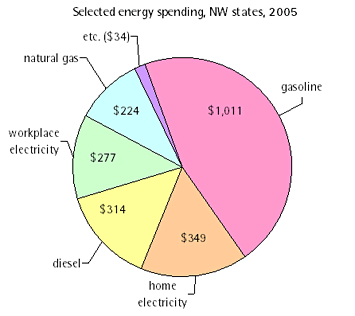Earlier in the week, I mentioned that energy spending per capita—money spent to fuel our cars and trucks, plus to heat, cool, and power our homes and workplaces—topped $2,200 per person in the Northwest states last year.
For any energy geeks who really care, there’s a breakdown in the chart below. On average, people spent over $1,000 on gasoline alone.
Once again, I think it’s important to emphasize two points.
First, as expensive as energy may seem, it’s still relatively cheap in the big scheme of things. Here’s an example. According to the American Automobile Association, for example, the cost of owning and operating a car (pdf document) has reached $7,834. But gasoline accounts for only 18 percent of the cost of driving. The biggest single cost is depreciation; insurance, taxes, maintenance, and financing all take a bite, too.
So that means that, even with today’s inflated gas prices, gasoline represents less than one-fifth of the total cost of driving.
And second—and more troubling, perhaps—is that we use so much energy, in so many different ways, that it’s hard to know where to start conserving. Obviously, gasoline represents the biggest single energy expense in the average household budget. But it’s still less than half of the average family’s energy spending. Even if we could cut overall per capita gas consumption by a third—a huge change—we’d still spend about $1,700 a year per person on energy. And that’s not even including any of the energy that gets consumed by heavy industry, farms, airplanes, boats, etc., ad nauseum.
My point: reforming the energy system is an enormous, complicated, and diffuse task—and there’s no single silver bullet that’s going to fix it.








